Farther than the distant sky
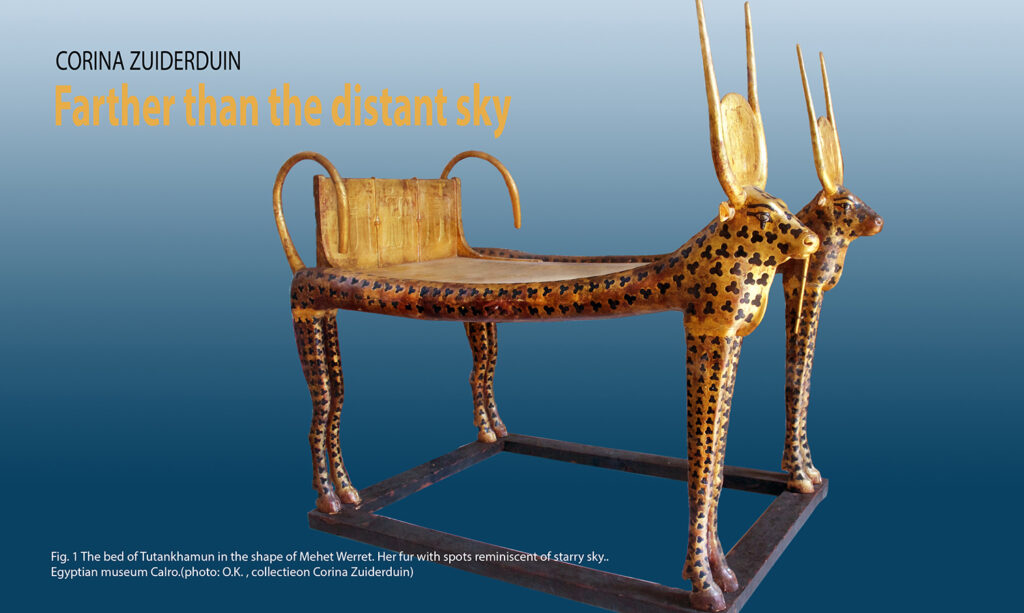
No one knew where the source of the Nile originated. But an Egyptian scribe thought he knew. His story, however, was particularly curious. A source without a bottom? A boundless depth?
Journey along the Nile
Nearly two and a half thousand years ago, the Greek historian Herodotus traveled through Egypt. He described what he encountered. He consulted various people about what he saw and what he wanted to know more about. One of the things he wondered about when he visited the land on the Nile was where the source of this great river originated. Where did all that water come from? The people he asked didn’t know. No one seemed to know. But he heard about an Egyptian scribe who knew more about it. This writer told him that the source of the Nile was near the first cataract, near the rocky part of the river. There the water would rise from the depths and flow in two directions. One flow would go south and the other flow north. The spring would be boundlessly deep.
According to the man, Pharaoh Psammentiches once measured the depth by means of a rope thousands of feet long. It had never touched the bottom. Herodotus heardthe story, wrote it down and thought his own way. In his own words, he could not take the man entirely seriously.[1]
This anecdote makes clear the confusion between a symbolic story and a concrete question. Herodotus asked about the literal source of the Nile. He was given a story about the mythical source of the Nile. We now know that the real Nile rises in the high plains of central Africa. But what about the mythical source? And above all, what is its significance?
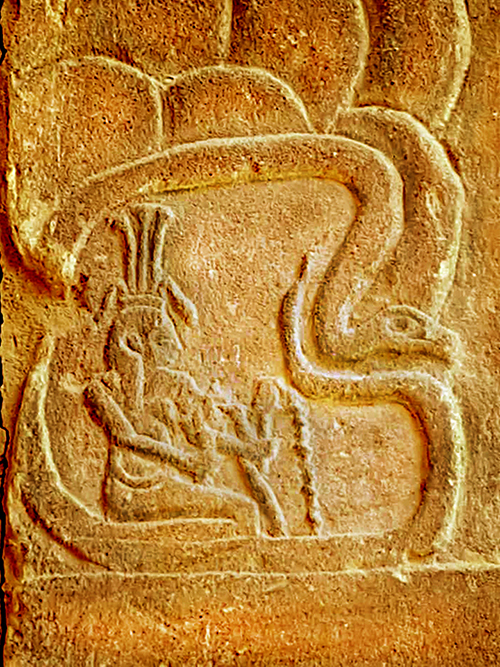
Origins
The story of the Egyptian scribe is derived from ancient Egyptian myths. These myths are as mysterious as the writer’s story. According to one of the myths, under the rocks of the first cataract, at the place where the Nile flows into the country, a peculiar creature named Hapi would reside. He would pour Nile water from two jars, causing the river to flow.
According to another myth, the Nile receives its water from Nun, a mysterious something, about which nothing can be said except that it is boundless and always exists. What is this mysterious boundlessness? And who is the eccentric figure Hapi?
Primal water
The priests who devised the myths had a philosophical view of where all life comes from. According to them, all beings issues from a boundless principle of life.
All beings, according to them, originate from a limitless principle of life. This was not “Nothingness,” but it was life, still without form. It was an infinite field of consciousness, in which all life was enclosed. The Egyptians called this Nun. Nun existed before anything took form. It always exists and always continues to exist. Nun is often compared to water, but it is not real water. ‘Primordial water’ it was called, or also referred to as ‘depth’ or described as ‘space’. Nun surrounded the earth and spread beyond the boundaries of the universe, like an ocean with no shores, no bottom, boundlessly deep to infinity.
Egyptian priests looked for an image to explain this idea. This they saw in the Nile flood. For thousands of years, the Nile caused great floods. Since the Aswan Dam was built, the Nile no longer floods, but before then, land flooded every July. Egyptian priests thought this was a very appropriate symbol. There was only water then, nothing else. As a result, it looked exactly like a vision of Nun.
Nun not only encompasses the earth but also permeates it. The Egyptians knew how to symbolize this very ingenious through the groundwater which they also called Nun. Thus, this reflected the idea that all beings not only originate from Nun, but are also permeated with it.
There is, according to the ancient Egyptians, nothing that is not alive. There is no dead substance. Even the earth, the stars and the mountains (that is, the minerals or atoms) are forms of life. And all those living beings, including plants, animals and humans, come forth from Nun.
There is another reason why the Nile flood is an appropriate symbol for Nun. This is because the flood brought fertility to the land with water and nourishing silt. Once the water subsided, life began. The first pieces of land raised above the surface, vegetation began to grow, birds and other animals appeared. The Nile flood was the source of all life. That is why it resembles Nun. Nun is also the source of all life.
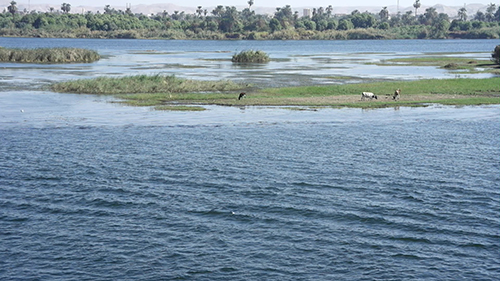
Primal gods

.
Nun is usually described in terms such as ‘boundlessness’, ‘darkness’, ‘the hidden’ and ‘primordial water’. The Egyptians loved personification. They loved to depict abstract concepts in the form of human, or half-human-half-animal forms. Similarly, they represented these concepts by depicting them in human forms with animal heads. Because in Nun energy (masculine) and matter (feminine) are still one, these concepts were given male and female names.
Heh, ‘infinity’ or ‘boundlessness’, received its female counterpart in Hehet. Amon, ‘the hidden’, got Amonet as its feminine side, Kek, ‘darkness’ got Keket and Nun, ‘primordial water’ had Nunet
These descriptions of Nun, these concepts, were called the eight primal gods. Figure 4 shows these ‘primeval gods’. The four male terms have the head of a frog, the four female have the head of a snake.
Mehet Weret
Another symbol for Nun is the heavenly cow Mehet Weret. In Fig. 5, she lies on a rectangle filled with water. It is the symbol for ‘spring’ or ‘lake’ or ‘sea’ and refers to the Primal Water. The cow itself also represents the primal water. Her name Mehet Weret says it all; Mehet Weret means ‘great flood’.
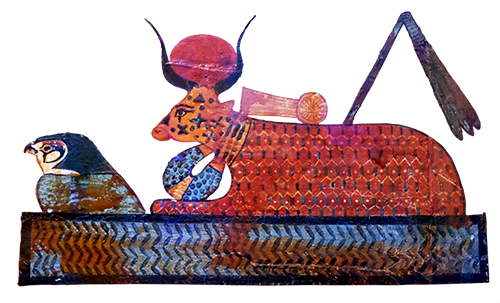
Hapi
But who is this peculiar creature that is said to dwell at the source of the Nile? That being named Hapi is also a representation of the Nile flood or rather of its deeper background: Nun. Hapi is also depicted both male and female. He has a beard and breasts. In the boundless All, energy and matter are still one. Nothing is yet separated. It is a state where ‘here are not yet two things’. The name Hapi also gives clarity. Hapi derives from the word meaning ‘to appear’, ‘to become’ or ‘to give life’.
The Egyptians came up with different symbols for the boundless principle of life. We have already seen some examples, namely Mehet Weret and the eight primeval gods. Hapi is also such a symbol. Although the Egyptians depicted Hapi as a human figure, they did not forget that Hapi is only a symbol. A hymn to Hapi clearly shows this. It says that no one knows his whereabouts and that Hapi cannot be represented in stone.[2] The statement is a reference to the indepictable essence of Hapi.
Hapi represents the boundless source that starts to flow as soon as a being takes shape. When a being unfolds from Nun, consciousness flows from the boundless to increasingly material areas and forms the body. At death and in sleep, consciousness flows back again.
With this, the story Herodotus heard becomes understandable. The unfathomable source of the Nile refers to the boundless depth of Nun. Figures 2 and 6 show Hapi with his two jars of Nile water.
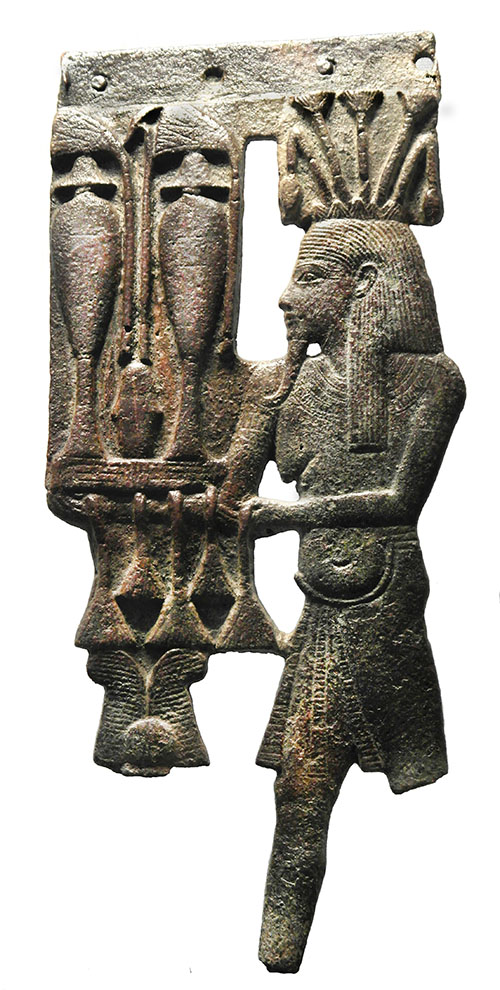
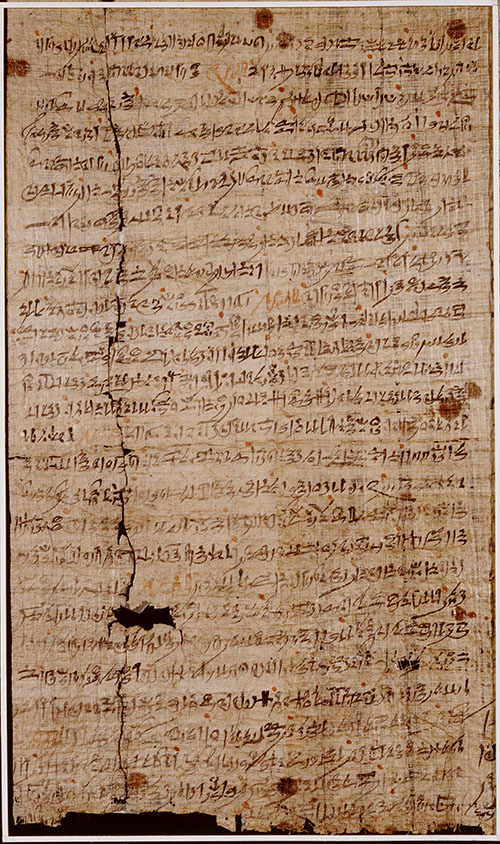
Amon hymn
Perhaps one of the most beautiful descriptions of Nun is the Amonhymn. The papyrus probably came from the lost Egyptian templelibraries. Today it is preserved at the National Museum of Antiquities in Leiden. In this text, Amon is equated with Nun:
‘He (Amon) is farther than the distant sky,
He is deeper than the Duat (underworld).
No god knows his true nature.
His image is not unfolded in the writings.
There is no perfect testimony of him.
He is too hidden for his prestigious majesty to be uncovered.
He is too great to be questioned, too powerful to be known.
One would instantly fall dead of fright if one pronounced his secret name, intentionally or not.
No god knows how to call him by his name.
Hidden Ba (soul) is his name, he is so mysterious.’ [3]
The text makes it clear that this hidden principle of life cannot be described or imagined. There is no good word to describe it. You cannot give it a name. You cannot ‘call it by its name’. No being knows this boundless All. Even beings more advanced than humans (gods) do not know it.
We would perhaps now describe the expression ‘fall dead of fright’ as ‘being in awe of something’, a way to convey the ‘overwhelming impression’ of this All. The expression also indicates that you will never be able to know this All completely. Nor can you, for if you were to know it, then you are no longer a separate being, but you are everything.
But thinking about it is very inspiring. That is probably why the Egyptians paid so much attention to it and kept coming up with new ways to symbolize it.
Before the earth existed
If Nun always exists and all beings originate from Nun, then in essence all beings must also have been existed always. The Egyptian therefore says that he was there ‘before the sky existed, before earth existed, before men existed, before the gods were born, before death existed’.[4] He was there “before that which was to be made firm existed.[5]
All beings always existed as centers of consciousness, according to the Egyptians. They have no form at first, but slumber in Nun until the time comes when they awaken and become active. They are born, have experiences in the world that allow them to develop. After some time, at the time of death, they are taken back into Nun to rest and process everything. And after a while, they awaken again. They are born again to continue their development. Exactly the same thing happens during sleep. Then too, according to the Egyptians, you return to Nun. One of Tutankhamun’s beds is shaped like Mehet Weret (Fig. 1). Every night Mehet Weret carries you on her back to Nun, according to one myth. Or as another myth tells, she takes you on her horns when you have become a sun. The next morning, she lifts the sun from Nun. You awaken again and life goes on.
This bed was placed in Tutankhamun’s tomb so that Mehet Weret could take him with her after his death. The sun or sungod in ancient Egypt is a symbol of the inner god, your deepest core. Tutankhamun leaves his body behind, but he himself, his inner core, is absorbed into a higher sphere.
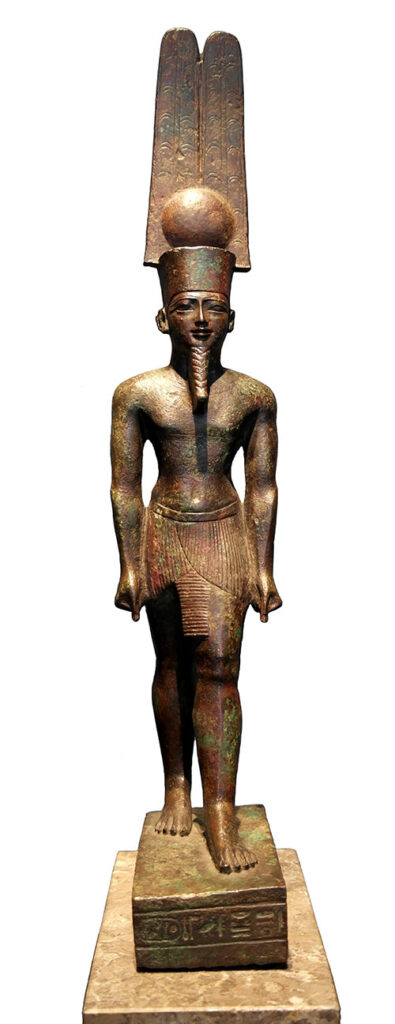

A drop of water
Every being is different. Each being is unique and expresses a limited part of the All. And yet the core of each being is bottomless deep, eternal, boundless. Therefore, unlimited possibilities of development lie within him and during each life he develops more of them.
Egyptian texts give the impression that man once originated unconsciously from Nun, as a beginning man, like a child. He ‘was fashioned by Nun on his left hand when he was a child who had no wisdom (yet),’ says a pyramid text.[6] He can return to the higher level from which he once left, as a fully conscious human being. He can develop wisdom and become a divine human being, an Osiris. Wennefer is the title often given to Osiris. Wen means ‘to be’ and nefer means ‘beautiful’, ’good’, ’perfect’. Wennefer is often translated as ‘the one who is always good’. He has then become a perfect human being and has learned everything he can learn as a human being. He has reached an endpoint. This endpoint is relative, because after a period of rest, life goes on again. He can again discover new worlds and develop even further. Every being can always develop further. Always one step higher. Nun is boundless.
I am Nun
All beings learn from each other. All beings need each other in the process. They grow together. And all beings return to Nun, to the ocean of Being, from which they were never actually separated. Always they were part of it. Each being is a drop of Primal Water. ‘I am Nun,’ says the Egyptian.[7] The waterbucket in Figure 9 is shaped like a drop of water. The bucket was used in temples and can be filled with water, symbolizing the same life that flows through all beings. Those who see that there is a unity underlying everything that exists see themselves in every being.
This article is an adaptation of an article that appeared in Bresmagazine februari 2024 and on the book het Mooie Westen, mythen en symbolen in Egypte (2019).
Copyright text and photo’s Corina Zuiderduin